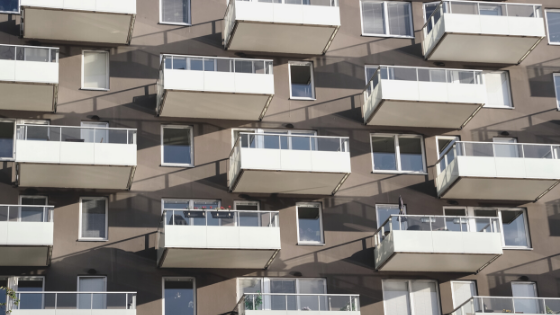
While a balcony is a wonderful asset to have, when it’s located in a strata title development, there are certain issues you need to be aware of – what’s common and what’s not when it comes to balcony/deck degradation.
According to some building authorities, a well maintained (properly constructed) balcony should last 40-50 years without much issue.
Balcony structural elements have several components:
- Balustrade, columns and railings
- Surface tiles
- Waterproof membrane
- Airspace
- Concrete slab, which may include:
- the balcony ceiling
- balcony doors, windows and walls
- awnings or pergolas
Despite looking simple, balconies are complex and should be treated as such.
The Most Common Issues with Strata Titled Balconies:
Other than “well maintained” there are other underlying assumptions including:
- The balcony was well designed in the first place with good drainage.
- The balcony and all its components were well constructed.
- Good quality and location appropriate materials were used in construction.
Water Leaks
The most common issue with body corporate balconies is, by far, water ingress.
Water leaks from a balcony can be into the lot or common property below or beside or into the subject lot.
Adequate drainage is the first issue that should be checked. An incorrect fall (resulting from poor design or construction) can funnel water directly into the lot or away from the appropriate drains.
Water pooling in also indicates poor draining.
Leaks to the lot below are, usually, indicators of a failure of the waterproof membrane.
There are lots of reasons membranes fail but poor workmanship accounts for up to 90% of failures. That can be everything from the slab being too wet to bond with the membrane, poor preparation of the surface, poor application of the membrane or subsequent tearing of the membrane when tiles are added or afterwards.
Leaks into the lot are more problematic since the failure may be the windows and doors rather than the balconies themselves. Or, as is often the case, the leaks have multiple causes.
If you have water ingress issues from your balcony have your own sliding doors checked first. If that proves not to be the cause of ingress, then report the matter to your strata manager.
If you have water ingress from the lot above or common property report straight to the strata manager.
Cracked or “Drummy” tiles
Tiles are laid over the waterproof membrane to which they bond providing protection for the membrane which itself stops water leaking into the lot below and protects the slab.
Sometimes expansion joints are inadequate, and the tiles push against each other as the slab moves. When that happens, the tiles can become de-bonded from the membrane and lift becoming “drummy”, named because of the hollow drumming sound they make with struck with something heavy.
Cracked tiles are, usually, the result of some sort of impact though it is possible that underlying issues can cause tiles to move and crack.
Cracked or lifted tiles need to be repaired as soon as possible. Movement of the tiles can tear the waterproof membrane. Even if the tiles come away cleanly it opens the way for water to penetrate to the membrane. It will have no way to drain away and can cause deterioration.
Repair of drummy or cracked tiles is lot owner responsibility.
If the cause of the problem comes from a structural issue such as concrete spalling the repair will be the OC responsibility.
Deterioration of the Balustrade or Fittings
Balustrades are made of all sorts of materials such as concrete, steel, wood, or glass. They are also fixed to the slab by either cementing in place or a complex arrangement of bolts.
All the materials are open to the elements and erosion or other deterioration will happen.
Regular maintenance is crucial. Concrete and steel balustrades should be painted regularly as painting seals the structure and prevents rust. Wooden balustrades, usually part of a wooden balcony, need to be treated regularly and inspected for evidence of wood rot and / or timber pests. Glass balustrades need to be cleaned and inspected regularly.
The most common balustrade issue is a breakdown of the connection to the slab. If bolts are used, they can rust weakening the structure.
When Balustrades No Longer Meet Australian Standards
Balustrades, like all building items, are subject to Australian Standards. Australian Standards are made more rigid, reasonably often, certainly more often than balcony balustrades are changed.
The changes to the Standards are not retroactive so if a non-compliant balustrade remains in good order then it’s a not an issue. The balustrade may be maintained, indefinitely.
There comes a point however when maintenance becomes a repair. Balustrades that are not compliant with Australian Standards may not be repaired.
It is common for a strata scheme with balustrade issues to find that replacement is their only option.
Concrete Cancer
Concrete cancer, or more correctly concrete spalling, is common in coastal areas.
For most buildings concrete cancer is a treatable problem.
Regular painting is crucial. The paint seals the concrete against moisture penetration. Painting goes hand in hand with inspection of the building and, if identified, repair of any spalling.
Balconies should be checked and painted regularly in concrete buildings as part of their regular maintenance.
Brick buildings by contrast do not need regular painting and balcony slabs are sometimes overlooked. The exposed concrete slab for the balcony should still be both inspected, painted and repaired if necessary.
If you’re unsure about any issues with your balcony, speak to your building or strata manager in the first instance.


